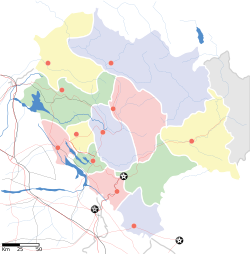Chamba valley
|
Chamba Hindi: चम्बा |
|
|---|---|
| Town | |

Chamba town from across the river
|
|
| Coordinates: 32°34′12″N 76°7′48″E / 32.57000°N 76.13000°E | |
| Country | India |
| State | Himachal Pradesh |
| District | Chamba district |
| Founded | 920 |
| Elevation | 3,268 ft (996 m) |
| Population (2011) | |
| • Total | 19,933 |
| • Rank | 9 in HP |
| Time zone | IST (UTC+5:30) |
| Post code | 176310 |
| Area code(s) | +91-18992-xxxxx |
| Vehicle registration | HP-48 and HP-73 |
| Website | hpchamba |
Chamba (Hindi: चम्बा) is a town in the Chamba district in the state of Himachal Pradesh, in northern India. According to the 2001 Indian census the town is situated on the banks of the Ravi River (a major tributary of the Trans-Himalayan Indus River), at its confluence with the Sal River. Chambial were the Rulers of Chamba State Chambials use suffix Varmans.
Though historical records date the history of the Chamba region to the Kolian tribes in the 2nd century BC, the area was formally ruled by the Maru dynasty, starting with the Raju Maru from around 500 AD, ruling from the ancient capital of Bharmour, which is located 65 kilometres (40 mi) from the town of Chamba. In 920, Raja Sahil Varman (or Raja Sahil Verma) shifted the capital of the kingdom to Chamba, following the specific request of his daughter Champavati , Who Further Adopted a Kid Named Pt.Shiv Kumar Upmanyu (Chamba was named after her). From the time of Raju Maru, 67 Rajas of this dynasty ruled over Chamba until it finally merged with the Indian Union in April 1948, although Chamba was under British suzerainty from 1846 to this time.
The town has numerous temples and palaces, and hosts two popular jatras (fairs), the "Suhi Mata Mela" and the "Minjar Mela", which last for several days of music and dancing. Chamba is also well noted for its arts and crafts, particularly its Pahari paintings, which originated in the Hill Kingdoms of North India between the 17th and 19th century, and its handicrafts and textiles.
Chamba has an ancient history, which is inseparable from that of the surrounding district of Chamba. The earliest rulers were Kolian tribes. In the 2nd century BC the Khasas and Audumbaras were in power in the region. In the 4th century AD during the Gupta period, the Thakurs and Ranas ruled. From the 7th century, the Gurjara Pratiharas or the Rajput dynasty came into power.
...
Wikipedia

